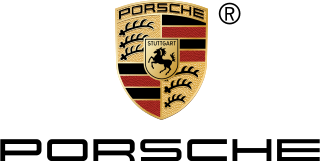
Dr.-Ing. h.c. F. Porsche AG, usually shortened to Porsche, is a German automobile manufacturer specializing in high-performance sports cars, SUVs and sedans, headquartered in Stuttgart, Baden-Württemberg, Germany,. The company is owned by Volkswagen AG, a controlling stake of which is owned by Porsche Automobil Holding SE. Porsche's current lineup includes the 718 Boxster/Cayman, 911, Panamera, Macan, Cayenne and Taycan.

The Porsche 356 is a sports car that was first produced by Austrian company Porsche Konstruktionen GesmbH (1948–1949), and then by German company Dr. Ing. h. c. F. Porsche GmbH (1950–1965). It was Porsche's first production automobile. Earlier cars designed by the Austrian company include Cisitalia Grand Prix race car, the Volkswagen Beetle, and Auto Union Grand Prix cars.

The Volkswagen Beetle—officially the Volkswagen Type 1, informally in German der Käfer, in parts of the English-speaking world the Bug, and known by many other nicknames in other languages—is a two-door, rear-engine economy car, intended for five occupants, that was manufactured and marketed by German automaker Volkswagen (VW) from 1938 until 2003.

Ferdinand Porsche was a German automotive engineer and founder of the Porsche car company. He is best known for creating the first gasoline-electric hybrid vehicle (Lohner-Porsche), the Volkswagen Beetle, the Auto Union racing car, the Mercedes-Benz SS/SSK, several other important developments and Porsche automobiles.

Tatra is a Czech vehicle manufacturer in Kopřivnice. It is owned by the Tatra Trucks company, based in Ostrava, and is the third oldest company in the world producing cars with an unbroken history. The company was founded in 1850 as Ignatz Schustala & Comp., in 1890 renamed in German Nesselsdorfer Wagenbau-Fabriksgesellschaft when it became a wagon and carriage manufacturer. In 1897, Tatra produced the first motor car in central Europe, the Präsident automobile. In 1918, it changed its name to Kopřivnická vozovka a.s., and in 1919 changed from the Nesselsdorfer marque to the Tatra badge, named after the nearby Tatra Mountains on the Czechoslovak-Polish border.

The Volkswagen Kübelwagen, or simply Kübel, is a light military vehicle designed by Ferdinand Porsche and built by Volkswagen during World War II for use by the Nazi German military. Based heavily on the Volkswagen Beetle, it was prototyped and first deployed in Poland as the Type 62, but following improvements entered full-scale production as the Type 82. Several derivative models, such as the Kommandeurswagen, were also built in hundreds, or in dozens.

A sports car is a car designed with an emphasis on dynamic performance, such as handling, acceleration, top speed, or thrill of driving. Sports cars originated in Europe in the early 1900s and are currently produced by many manufacturers around the world.
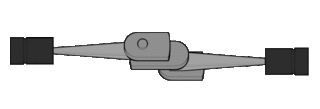
A flat engine, also known as a horizontally opposed engine, is a piston engine where the cylinders are located on either side of a central crankshaft. A flat engine should not be confused with the opposed-piston engine, in which each cylinder has two pistons sharing a central combustion chamber.

Ferdinand Anton Ernst Porsche, mainly known as Ferry Porsche, was an Austrian-German technical automobile designer and automaker-entrepreneur. He operated Porsche AG in Stuttgart, Germany. His father, Ferdinand Porsche, Sr. was also a renowned automobile engineer and founder of Volkswagen and Porsche. His nephew, Ferdinand Piëch, was the longtime chairman of Volkswagen Group, and his son, Ferdinand Alexander Porsche, was involved in the design of the 911.
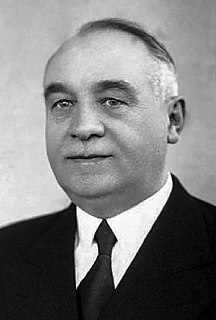
Hans Ledwinka was an Austrian automobile designer.

In automotive design, an RR, or rear-engine, rear-wheel-drive layout places both the engine and drive wheels at the rear of the vehicle. In contrast to the RMR layout, the center of mass of the engine is between the rear axle and the rear bumper. Although very common in transit buses and coaches due to the elimination of the drive shaft with low-floor buses, this layout has become increasingly rare in passenger cars.

Austro-Daimler was an Austro-Hungarian automaker company, from 1899 until 1934. It was a subsidiary of the German Daimler-Motoren-Gesellschaft (DMG) until 1909.
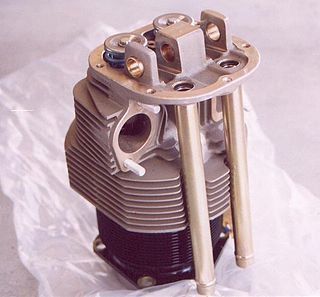
Air-cooled engines rely on the circulation of air directly over heat dissipation fins or hot areas of the engine to cool them in order to keep the engine within operating temperatures. In all combustion engines, a great percentage of the heat generated escapes through the exhaust, not through the metal fins of an air-cooled engine (12%). About 8% of the heat energy is transferred to the oil, which although primarily meant for lubrication, also plays a role in heat dissipation via a cooler. Air-cooled engines are used generally in applications which would not suit liquid cooling, as such modern air-cooled engines are used in motorcycles, general aviation aircraft, lawn mowers, generators, outboard motors, pump sets, saw benches and auxiliary power units.

The Volkswagen Type 18A a limited production variant of the Volkswagen Type 1 made for the German police that started production in 1949. In German it was called "Polizei Cabriolet" or Gendarmerier. It was also used by East Berlin's fire department. In total 482 were made, 203 by Karosserie Austro-Tatra. The lack of doors made it easy to get in or out of the car, but made it uncomfortable during the winter. The floorpan was strengthened, but the engine was a stock Type 1 engine producing 25 hp (19 kW), with a top speed of 100 km/h (62 mph). The brakes were mechanical.

The Tatra 97 (T97) is a Czechoslovak mid-size car built by Tatra in Kopřivnice, Moravia from 1936 to 1939.
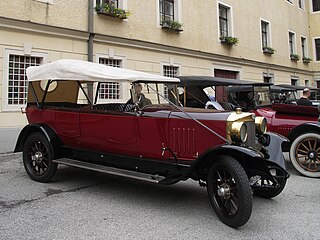
Steyr was an Austrian automotive brand, established in 1915 as a branch of the Österreichische Waffenfabriks-Gesellschaft (ÖWG) weapon manufacturing company. Renamed Steyr-Werke AG in 1926 and merged with Austro-Daimler and Puch into Steyr-Daimler-Puch AG, it continued manufacturing Steyr automobiles until 1959.
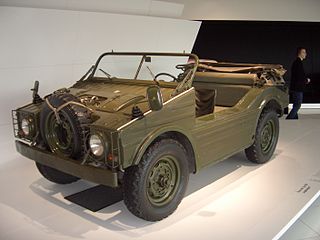
The Porsche 597Jagdwagen was a light military vehicle, designed to fill the same general role as the Jeep, Kübelwagen and Land-Rover.

The Tatra 57 are a series of two-door compact cars, built by Czechoslovakian company Tatra from 1932. They are popularly known by the nickname "Hadimrška".
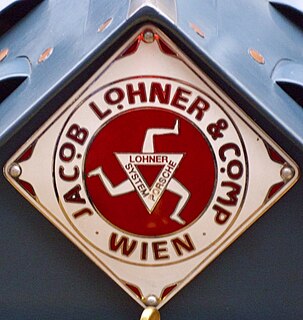
Lohner-Werke or simply Lohner, was a Viennese luxury coachbuilding firm founded in the 19th century by Jacob Lohner.

Edmund Elias Rumpler was an Austrian automobile and aircraft designer.
























